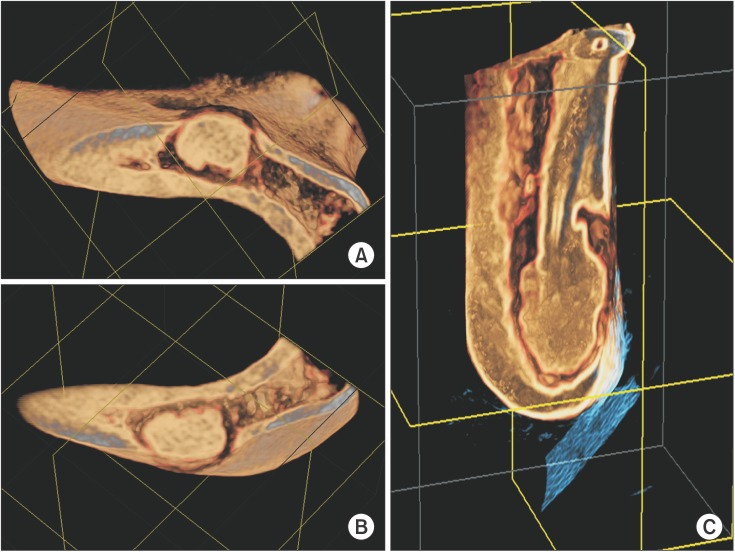1. Neville BW, Damm DD, Allen CM, Bouquot JE. Oral and maxillofacial pathology. 2nd ed. Philadelphia: W.B. Saunders;2002.
2. Barnes L, Eveson JW, Reichart P, Sidransky D. World Health Organization classification of tumors pathology & genetics head and neck tumors. Lyon: IARC Press;2005.
3. Noffke CE, Raubenheimer EJ, MacDonald D. Fibro-osseous disease: harmonizing terminology with biology. Oral Surg Oral Med Oral Pathol Oral Radiol. 2012; 114:388–392. PMID:
22862981.

4. Brannon RB, Fowler CB, Carpenter WM, Corio RL. Cementoblastoma: an innocuous neoplasm? A clinicopathologic study of 44 cases and review of the literature with special emphasis on recurrence. Oral Surg Oral Med Oral Pathol Oral Radiol Endod. 2002; 93:311–320. PMID:
11925541.

5. Pynn BR, Sands TD, Bradley G. Benign cementoblastoma: a case report. J Can Dent Assoc. 2001; 67:260–262. PMID:
11398388.
6. White SC, Pharoah MJ. Oral radiology: principles and interpretation. 6th ed. St. Louis: Mosby;2009.
7. Monti LM, Souza AM, Soubhia AM, Jorge WA, Anichinno M, Da Fonseca GL. Cementoblastoma: a case report in deciduous tooth. Oral Maxillofac Surg. 2013; 17:145–149. PMID:
22855308.

8. Ohki K, Kumamoto H, Nitta Y, Nagasaka H, Kawamura H, Ooya K. Benign cementoblastoma involving multiple maxillary teeth: report of a case with a review of the literature. Oral Surg Oral Med Oral Pathol Oral Radiol Endod. 2004; 97:53–58. PMID:
14716256.

9. Karaçal N, Agdoğan Ö, Livaoğlu M, Uraloğlu M, Özel B. Giant cementoblastoma of the impacted mandibular incisor. J Craniofac Surg. 2011; 22:e26–e27. PMID:
22134313.

10. Papageorge MB, Cataldo E, Nghiem FT. Cementoblastoma involving multiple deciduous teeth. Oral Surg Oral Med Oral Pathol. 1987; 63:602–605. PMID:
3473380.

11. Hirai E, Yamamoto K, Kounoe T, Kondo Y, Yonemasu H, Kurokawa H. Benign cementoblastoma of the anterior maxilla. J Oral Maxillofac Surg. 2010; 68:671–674. PMID:
20171487.

12. Costa FW, Pereira KM, Magalhães Dias M, da Costa Miguel MC, de Paula Miranda MA, Studart Soares EC. Maxillary cementoblastoma in a child. J Craniofac Surg. 2011; 22:1910–1913. PMID:
21959464.

13. Slimani F, Elbouihi M, Oukerroum A, Lazreqh H, Mahtar M, Karkouri M, et al. Maxillary cementoblastoma. A case report. Rev Med Brux. 2009; 30:185–188. PMID:
19642490.
14. Keyes G, Hilderbrand K. Successful surgical endodontics for benign cementoblastoma. J Endod. 1987; 13:566–569. PMID:
3482232.

15. Brocheriou C, Guilbert F, Matar A, Champion P, Couly G. Benign cementoblastoma of jaws: report of 6 cases and review of the literature (author's transl). Arch Anat Cytol Pathol. 1979; 27:29–34. PMID:
453932.
16. Souza AS, Cardoso JA, Silva VP, Oliveira MC, Azoubel E, Farias JG. Cementoblastoma affecting the maxilla of a pediatric patient: a case report. Rev Port Estomatol Med Dent Cir Maxillofac. 2013; 54:43–47.

17. Eversole LR, Sabes WR, Dauchess VG. Benign cementoblastoma. Oral Surg Oral Med Oral Pathol. 1973; 36:824–830. PMID:
4524834.

18. Slootweg PJ. Cementoblastoma and osteoblastoma: a comparison of histologic features. J Oral Pathol Med. 1992; 21:385–389. PMID:
1432731.

19. Lee JM, Song WW, Lee JY, Hwang DS, Kim YD, Shin SH, et al. Clinical study of benign and malignant fibrous-osseous lesions of the jaws. J Korean Assoc Oral Maxillofac Surg. 2012; 38:29–37.






 PDF
PDF ePub
ePub Citation
Citation Print
Print






 XML Download
XML Download